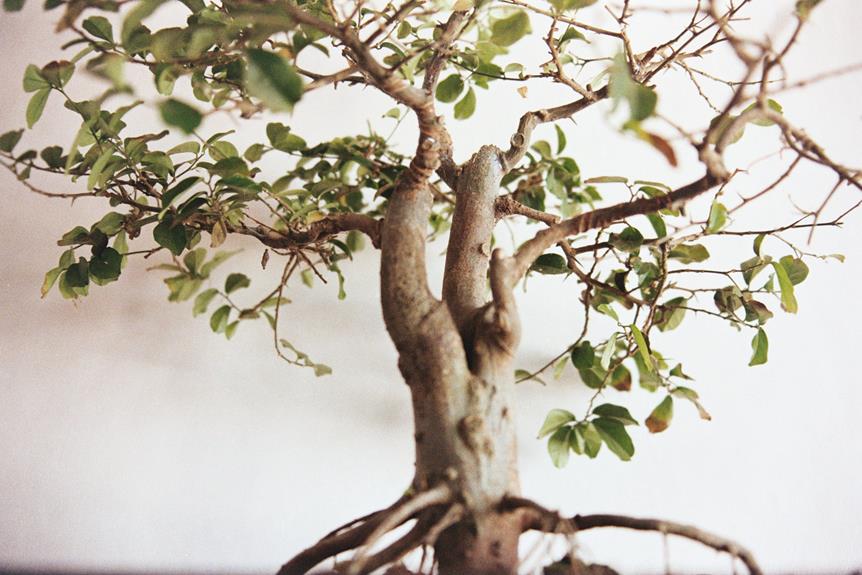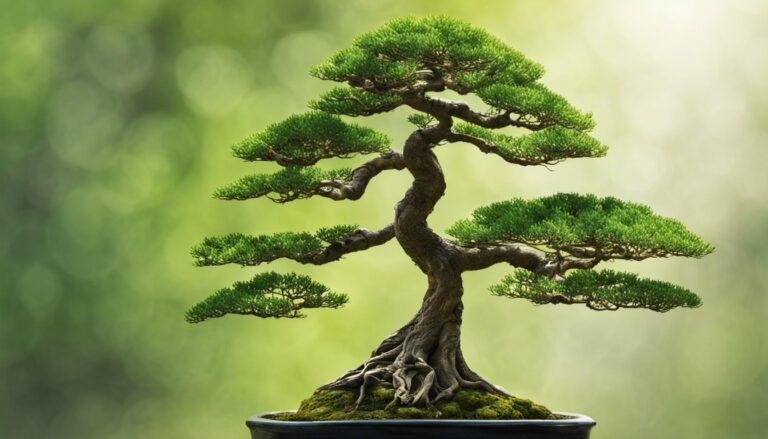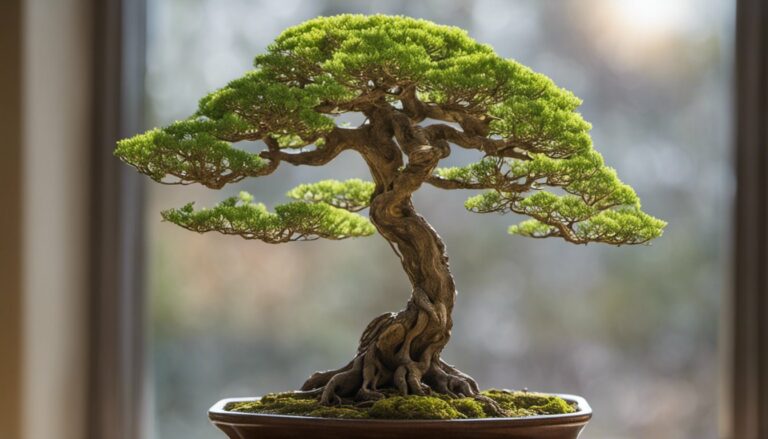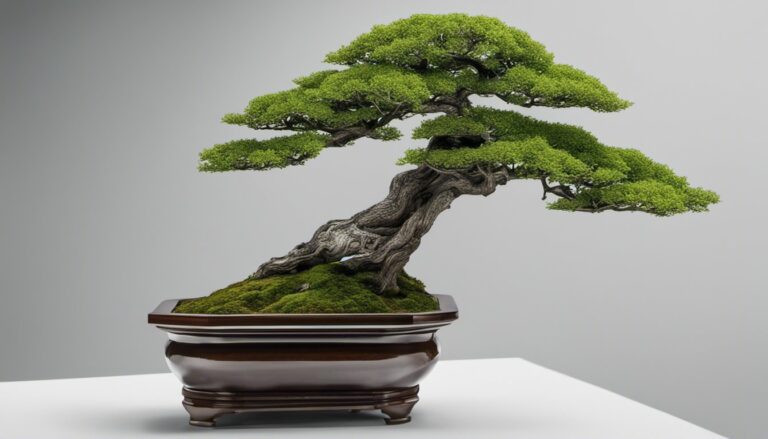Bonsai Trunk Chopping: Secrets to Creating Stunning Styles
Are you tired of your bonsai trees looking ordinary and lacking that wow factor? Imagine transforming a modest bonsai into a stunning work of art that catches everyone's eye.
Well, with the secrets of bonsai trunk chopping, you can do just that. By strategically cutting the trunk, you can create breathtaking styles that will leave everyone in awe. Whether you want to achieve a majestic cascading style or a windswept masterpiece, trunk chopping holds the key.
In this article, we will explore the techniques and methods used to create these stunning styles, as well as the benefits and drawbacks of trunk chopping.
Get ready to take your bonsai designs to a whole new level with the art of trunk chopping.
Key Takeaways
- Bonsai trunk chopping improves the aesthetics of the bonsai tree and adds taper and girth to the trunk.
- Different trunk chopping methods, such as the blind trunk chop and the v-cut technique, are used for specific bonsai styles.
- Bonsai styles include sumo bonsai, spreading style bonsai, moyogi style bonsai, and more, each requiring different trunk chopping techniques.
- The best tree species for bonsai trunk chop include Elms, Acer, Maples, Oak, and Ficus species, and it may take 2 to 5 years to see the results of a trunk chop.
Benefits of Bonsai Trunk Chopping
One of the primary benefits of bonsai trunk chopping is that it significantly improves the aesthetics of your bonsai tree. By strategically removing sections of the trunk, you can create a more visually pleasing and natural-looking bonsai. Trunk chopping also adds taper and girth to the trunk, enhancing the overall shape and proportion of the tree.
This technique is particularly effective for larger-sized trunks that need a new leader branch. However, it's crucial to execute the trunk chop correctly to avoid damaging the tree. Improper execution can result in long-term negative effects and require a significant amount of time to see the desired benefits.
Therefore, it's essential to approach trunk chopping with knowledge and precision to achieve the desired results for your bonsai tree.
Different Trunk Chopping Techniques
To achieve stunning bonsai styles, you can explore different trunk chopping techniques. These techniques play a crucial role in shaping the overall appearance of your bonsai tree.
Two commonly used methods are the blind trunk chop and the V-cut technique. The blind trunk chop is effective for creating thicker branches in vertical bonsai styles like sumo bonsai. On the other hand, the V-cut technique is ideal for creating bonsai styles with many bends, such as moyogi styles.
Keep in mind that the effectiveness of these methods depends on the desired bonsai style. For sumo bonsai, the blind trunk chop is used to create a short and thick trunk, while the V-cut chopping technique is used for spreading style bonsai to create longer, thinner branches with a wider canopy.
Experimenting with different trunk chopping techniques will help you achieve the desired aesthetics in your bonsai design.
Trunk Chopping for Specific Bonsai Styles
For each specific bonsai style, you can achieve stunning results by applying the appropriate trunk chopping techniques. Different bonsai styles require different approaches to trunk chopping in order to create the desired shape and aesthetics. Here is a table that outlines the trunk chopping techniques used for specific bonsai styles:
| Bonsai Style | Trunk Chopping Technique |
|---|---|
| Sumo Bonsai | Blind trunk chop |
| Spreading Style | V-cut chopping |
| Moyogi Bonsai | V-cut chopping |
In sumo bonsai, a blind trunk chop is used to create a short and thick trunk, replicating the appearance of ancient, weathered trees. On the other hand, spreading style bonsai aims to mimic the natural look of oak trees in the wild, and the v-cut chopping technique is used to create longer, thinner branches with a wider canopy. Moyogi bonsai, which is a relatively upright and straight style with some bends, also utilizes the v-cut chopping technique to achieve the desired shape and bends. By understanding the specific trunk chopping techniques for each bonsai style, you can create stunning bonsai trees that capture the essence of nature.
Creating Stunning Styles With Trunk Chopping
To create stunning styles with trunk chopping, you can achieve remarkable results by applying specific techniques and utilizing the appropriate bonsai styles. Here are three key elements to consider:
- Choose the right bonsai style: Different bonsai styles require different trunk chopping techniques to create the desired aesthetic. For example, if you want to create a sumo bonsai with a short and thick trunk, the blind trunk chop method would be most effective. On the other hand, if you're aiming for a spreading style bonsai that replicates the natural look of oak trees, the v-cut technique is more suitable.
- Understand the tree species: Some tree species respond better to trunk chopping than others. Elms, Acer, Maples, Oak, and Ficus species are known to be more resilient and suitable for trunk chopping. Make sure to choose the right species to achieve the desired results.
- Patience and maintenance: Trunk chopping takes time to show results. It may take 2 to 5 years for the new branches to grow and develop. Regular maintenance, such as pruning and wiring, is crucial to shaping and maintaining the desired style.
Best Tree Species and Alternatives for Trunk Chopping
When choosing tree species for trunk chopping, consider the resilience and suitability of Elms, Acer, Maples, Oak, and Ficus species. These tree species have proven to be excellent choices for bonsai enthusiasts looking to create stunning styles through trunk chopping.
Elms are known for their strong root systems and ability to recover quickly after pruning.
Acer and Maples offer beautiful foliage and can develop intricate branch structures.
Oaks provide a sturdy and majestic appearance, while Ficus species have the advantage of being able to grow both indoors and outdoors.
As alternatives to trunk chopping, you can explore growing sacrificial branches, using tourniquets, splitting a bonsai trunk, or following the scarring technique.
Each alternative method offers its own unique benefits and challenges, so choose the one that best suits your desired bonsai style.
Conclusion
In conclusion, bonsai trunk chopping is a powerful technique that can transform your bonsai designs and take them to new heights. By understanding the benefits and drawbacks, as well as the different trunk chopping techniques, you can create stunning styles that showcase the beauty and artistry of bonsai.
With the right tree species and alternatives, you can achieve breathtaking results and see the transformation over time. So, embrace the secrets of bonsai trunk chopping and watch your designs flourish.







